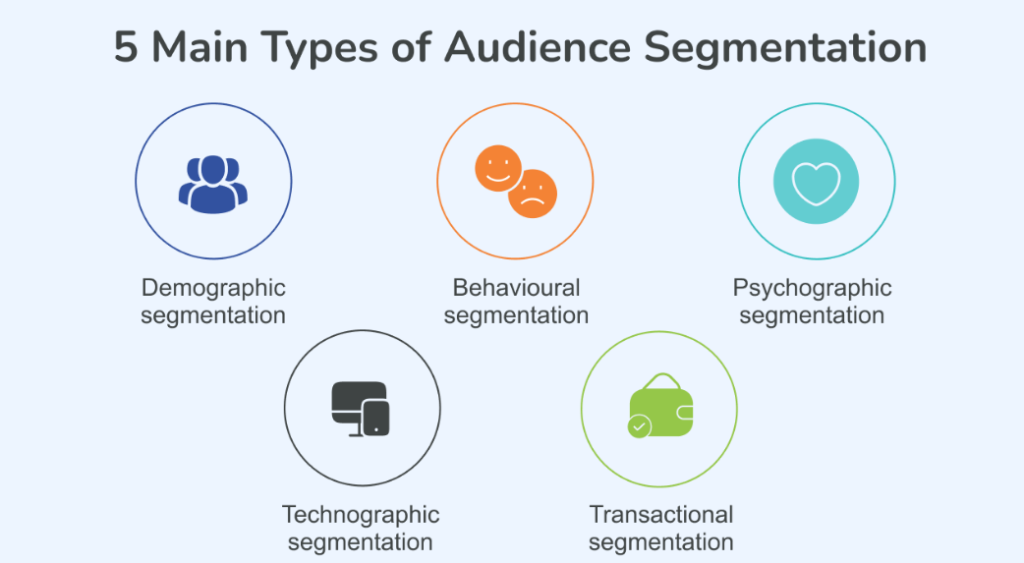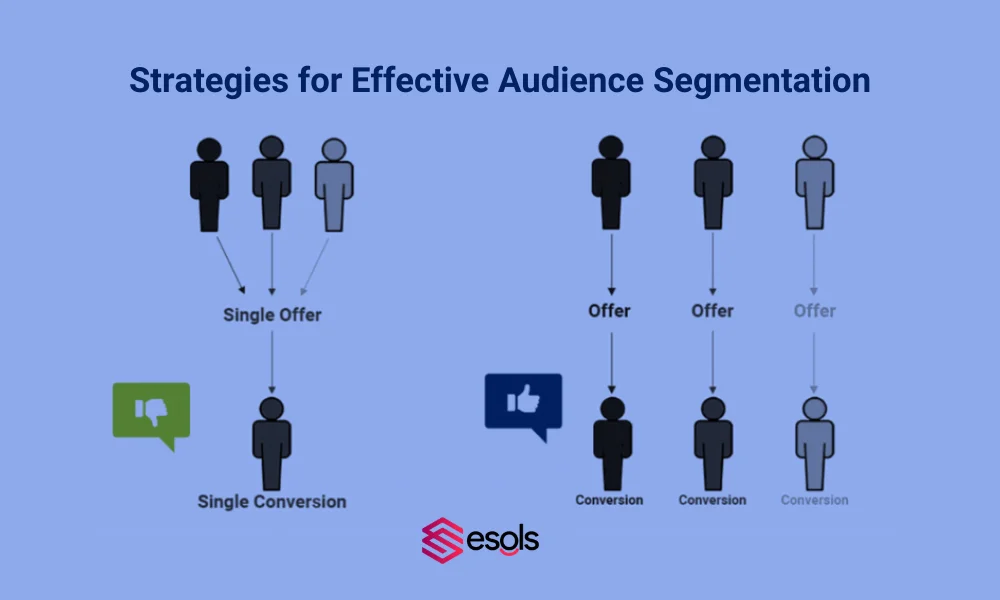Effective audience segmentation is essential for businesses looking to optimize their marketing strategies and improve customer engagement. By dividing your audience into distinct groups based on shared characteristics, you can tailor your messaging and offerings to meet the specific needs of each segment.
In this blog post, we will explore five proven strategies for effective audience segmentation, helping you enhance your marketing efforts and drive better results.

Table of contents
Demographic Segmentation
Demographic segmentation involves dividing your audience based on identifiable characteristics such as age, gender, income, education level, and family size. This approach allows marketers to target specific groups more effectively and create campaigns that resonate with their audience.
Benefits of Demographic Segmentation
- Personalization: Tailor your messaging to align with the interests and preferences of different demographic groups.
- Targeted Offers: Design promotions that appeal to specific income levels or life stages.
- Improved ROI: By focusing on the right audience, you can increase conversion rates and drive higher returns on investment.
- Strategic Planning: Utilize demographic data to anticipate market trends and inform future marketing strategies.
Example
A cosmetics brand might create different campaigns for teenagers, young adults, and older customers, focusing on their unique skincare concerns and preferences.
Psychographic Segmentation
Psychographic segmentation categorizes your audience based on their interests, values, lifestyles, and personality traits. This method goes beyond basic demographics to understand the motivations driving customer behavior.
Benefits of Psychographic Segmentation
- Deeper Insights: Gain a better understanding of what influences your audience’s purchasing decisions.
- Enhanced Messaging: Develop campaigns that resonate emotionally, leading to stronger connections with your brand.
- Increased Loyalty: By aligning your brand with customers’ values, you can foster loyalty and advocacy.
- Better Customer Retention: Tailor your customer service approaches based on psychographic insights, enhancing retention rates.
Example
A fitness brand may target health-conscious individuals who prioritize eco-friendly products, creating campaigns that emphasize sustainability alongside health benefits.
Behavioral Segmentation
Behavioral segmentation focuses on how consumers interact with your brand, including their purchasing behavior, usage patterns, and engagement levels. This approach allows you to tailor marketing efforts based on actual customer actions rather than just assumptions.
Benefits of Behavioral Segmentation
- Actionable Insights: Use customer behavior data to drive decision-making and marketing strategies.
- Improved Customer Experience: Customize interactions based on customer needs and preferences, enhancing their experience.
- Higher Engagement: Target customers with relevant messaging based on their past behaviors, increasing the likelihood of conversion.
- Predictive Modeling: Leverage behavioral data to forecast future purchasing behaviors, allowing proactive marketing efforts.
Example
An e-commerce platform can analyze customer purchase history to identify loyal customers and target them with exclusive offers, boosting retention.
Geographic Segmentation
Geographic segmentation divides your audience based on their location, including country, region, city, or even neighborhood. This strategy allows marketers to consider local preferences and cultural differences in their campaigns.
Benefits of Geographic Segmentation
- Localized Marketing: Tailor your messaging to resonate with specific communities and cultures.
- Targeted Promotions: Develop location-specific promotions or events to engage local audiences.
- Market Expansion: Identify opportunities for growth in new geographic areas by analyzing regional trends.
- Cultural Relevance: Adjust your marketing campaigns to reflect local customs and values, enhancing relatability.
Example
A restaurant chain may offer different menu items or promotions based on regional tastes and preferences, appealing to local customers more effectively.
Technographic Segmentation
Technographic segmentation categorizes your audience based on their technology usage and preferences, including device types, software applications, and online behaviors. This strategy is particularly important in today’s digital landscape.
Benefits of Technographic Segmentation
- Optimized User Experience: Create campaigns that cater to the preferred devices and platforms of your audience.
- Informed Product Development: Use insights on technology preferences to guide product development and feature enhancements.
- Enhanced Targeting: Reach tech-savvy consumers with advanced features and tools that appeal to their needs.
- Competitive Advantage: Stay ahead of competitors by leveraging the latest technology trends to meet customer expectations.
Example
A software company might segment its audience based on whether they prefer desktop applications or mobile apps, tailoring their marketing strategies accordingly.
Conclusion
Effective audience segmentation is vital for crafting targeted marketing strategies that resonate with specific consumer groups. By implementing these five proven strategies demographic, psychographic, behavioral, geographic, and technographic segmentation—you can enhance customer engagement, improve conversion rates, and ultimately drive better business outcomes. Remember, the more you know about your audience, the better you can serve them.
Read more : Transform Your Marketing with Audience Segmentation
FAQs
Audience segmentation is the process of dividing your target market into distinct groups based on shared characteristics, allowing for more tailored marketing strategies.
Audience segmentation helps businesses deliver personalized marketing messages, improve customer engagement, and increase conversion rates by targeting specific groups effectively.
The main types of audience segmentation include demographic, psychographic, behavioral, geographic, and technographic segmentation.
You can gather data through surveys, customer feedback, website analytics, social media insights, and purchase history to better understand your audience.
Yes, by targeting the right audience with tailored messages and offers, you can significantly enhance your marketing ROI through higher conversion rates.

Smith
Welcome to my blog! As a digital marketing expert with over 15 years of experience, I’ve witnessed the transformative power of search engine optimization from the very beginning of my career. In this blog series, I’ll delve into the crucial role SEO and marketing play in the success of small businesses. Join me on this journey to uncover how leveraging data-driven insights and innovative SEO techniques can propel your small business to new heights, attract a broader audience, and drive sustainable growth in the digital age. Whether you’re a seasoned entrepreneur or just starting out, you’ll find valuable insights and practical tips to enhance your digital marketing strategies.


